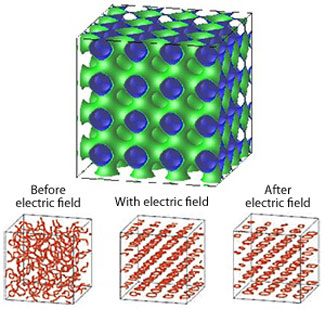| Jun 06, 2011 |
Liquid crystals: Jogging a pore memory
|
|
(Nanowerk News) Liquid-crystal displays are often the most energy-hungry components in mobile devices, so researchers are interested in finding new ways to control them that require less power. Now, using computer simulations, scientists at the University of Tokyo in Japan in collaboration with colleagues at the University of Milan in Italy have uncovered a memory effect in liquid crystals that could, according to group leader Hajime Tanaka, point to new ways of preparing low-power electronic paper and other optoelectronic devices ("Memory and topological frustration in nematic liquid crystals confined in porous materials").
|
|
The 'nematic' liquid crystals that form the pixels in most electronic displays consist of oblong molecules that, below a certain temperature and in an electric field, align in a uniform direction. A pixel will block light if the light and the molecules are polarized in different directions, but transmit light if the polarizations are parallel.
|
 |
| Schematic illustrations of a bicontinuous porous structure (top), and the orientation of liquid crystals (bottom) on the structure before, during and after the application of an electric field. (© 2011 NPG)
|
|
Such displays require a constant supply of power to control the molecular orientation. To get around this problem, Tanaka and his collaborators found that the geometry of the substrate supporting the liquid crystals may be sufficient to keep the molecules oriented.
|
|
Through simulations, the group studied how liquid crystals confined inside a porous structure and preferring to align perpendicular to the surface of the pores respond to an electric field. In such a system, a sufficiently strong electric field partially polarizes the molecules in one direction, but competes with the specific ordering favored by the surface, causing line defects to form and the molecules to reorient extremely slowly, like the atom configurations in glass.
|
|
The group showed that the molecules remain partially polarized even when the field is removed and that this memory effect is strongest in 'bicontinuous' porous structures (see image), where both the pores and the surface of the material are continuous. It is the geometry and topology of these structures, explains Tanaka, that prevent the line defects from moving and allow the liquid crystal to 'remember' a particular orientation.
|
|
Such porous scaffolds could be the basis for making low-power optical devices with two polarization states. "Functionalizing materials by geometry or topology is not limited to liquid crystals," says Tanaka, who suggests that these ideas could also apply to ferromagnets.
|

